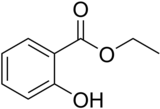
| |

| |
| Names | |
|---|---|
| Preferred IUPAC name Ethyl 2-hydroxybenzoate | |
| Identifiers | |
| CAS Number | |
| 3D model (JSmol) | |
| ChemSpider | |
| ECHA InfoCard | 100.003.878 |
| PubChem CID | |
| UNII | |
| CompTox Dashboard (EPA) | |
InChI
| |
SMILES
| |
| Properties | |
| Chemical formula | C9H10O3 |
| Molar mass | 166.176 g·mol |
| Appearance | Colorless liquid |
| Odor | wintergreen |
| Density | 1.13 g/cm |
| Melting point | 1.3 °C (34.3 °F; 274.4 K) |
| Boiling point | 232 °C (450 °F; 505 K) |
| Except where otherwise noted, data are given for materials in their standard state (at 25 °C , 100 kPa).
| |
Ethyl salicylate is the ester formed by the condensation of salicylic acid and ethanol. It is a clear liquid that is sparingly soluble in water, but soluble in alcohol and ether. It has a pleasant odor resembling wintergreen and is used in perfumery and artificial flavors.
See also
References
- Pubchem. "Ethyl salicylate". pubchem.ncbi.nlm.nih.gov. Retrieved 25 February 2018.
- ^ Record in the GESTIS Substance Database of the Institute for Occupational Safety and Health
- ^ Lapczynski, A; McGinty, D; Jones, L; Bhatia, S; Letizia, C.S; Api, A.M (2007). "Fragrance material review on ethyl salicylate". Food and Chemical Toxicology. 45: S397–401. doi:10.1016/j.fct.2007.09.043. PMID 18023517.
This article about an ester is a stub. You can help Misplaced Pages by expanding it. |